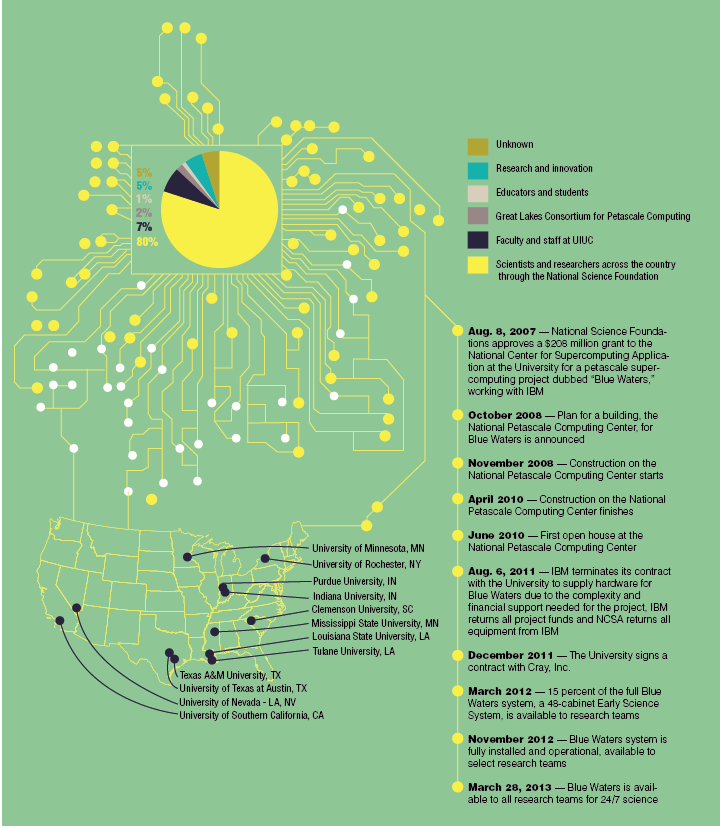Blue Waters facility hosts open house for students, faculty
August 25, 2015
Blue Waters, the University’s powerful supercomputer, has a home that surges with even more capability.
At the National Petascale Computing Facility, water rushes through pipes in the floor, preventing the supercomputer from melting into a pile of plastic and metal. Ten megawatts of power course through the building to sustain the supercomputer and 49,000 more processors that perform calculations in tandem.
Even the seemingly endless sea of Cray cabinets that house those processors — mammoth black matte boxes — are physically imposing as they whir in harmony.
Students and faculty alike will have the opportunity to experience the power within the supercomputer and its home, as well as learn about research conducted with it, through the #IllinoisWelcome open house, which is offered by the National Center for Supercomputing Applications (NCSA) this Friday from 3-5 p.m.
Any time during the open house, visitors can participate in a self-guided tour of the facility, where the machine and viewing deck will be open. In addition, people will be able to look at the infrastructure of the building, which includes the power transformer and the water pump room.
Get The Daily Illini in your inbox!
In addition to informational boards, people can talk to on-site staff as they walk through the tour with any questions they have.
Elizabeth Murray, media communications specialist for the NCSA, explained that the “#IllinoisWelcome” hashtag began at the University level, when it was used to welcome new and returning students to campus. Previously, they offered Petascale Day on Oct. 15, independent from the University, but the success of those open houses and the #IllinoisWelcome led them to join in the welcoming effort.
“We thought (an open house) might be a good idea to welcome people to campus and invite them to see something that potentially was a draw for them to come for or had heard about in theory, and they just didn’t really know what it was,” Murray said. “We found that (the open house) was popular and that people appreciated it. As a part of NCSA, our mission as a whole, much with the University, is education, innovation and discovery, and always moving forward.”
The fact that the NCSA is able to offer tours of the facility to the public is part of what makes Blue Waters so unique.
“A lot of data centers and supercomputers across the country have classified research. Blue Waters does not have classified research. We’re for open science,” Murray said. “So everything that Blue Waters helps enable is public knowledge, so there’s nothing super secret happening there. … We want to carry that over to the community and say, ‘Hey, we’re also open for you to come see what this looks like.’”
While researchers across the company have to compete with each other for access by applying to the National Science Foundation, researchers at the University only have to compete against the other researchers at the University, increasing the likelihood that they are able to obtain use of the supercomputer.
The supercomputer even has a total of 12 professors that are allocated a specific amount of time to work with it.
One Blue Waters professor, Larry Di Girolamo, said the campus benefits from the allocation, not just through research developments but also through collaboration with people from different disciplines. The research will impact students, too.
“We want those brains and that kind of knowledge here locally, both benefitting our students because they’re teaching and sharing their research here with our students but also benefitting their field and discovery process,” Murray said. “It’s a big deal to have (Blue Waters) here at the University, and we’re very proud to have it here.”
However, in producing research that contributes to the science and local community, Blue Waters is set apart by those who help it to run smoothly — the support team. Blue Waters professor Andre Schleife found the team helpful when computing complex matrices for his research. Blue Waters can only run for 24 hours at a time, making it difficult and time-consuming to read each matrix — approximately one terabyte — that he was computing.
“I talked to a couple people (on the support team) who gave me some suggestions on how I could accelerate the reading because Blue Waters has a really parallelized way of reading large amounts of data. Also, the code we use right now does not use that, and they started to help me (learn) how to benefit from these parallel-reading capabilities,” Schleife said.
In addition to the ways Blue Waters impacts the community through research, Murray said that the open houses have been useful in reaching out to students and faculty.
“It’s really helping us get the message out there that Blue Waters is for everybody, it’s for the advancement of our whole society. We’re not hiding anything, and we want you to come learn more,” Murray said. “Because of that open science and open nature, we get to translate that into our outreach as well, that people can come learn more and that they shouldn’t feel intimidated and they should feel welcome to do so.”







